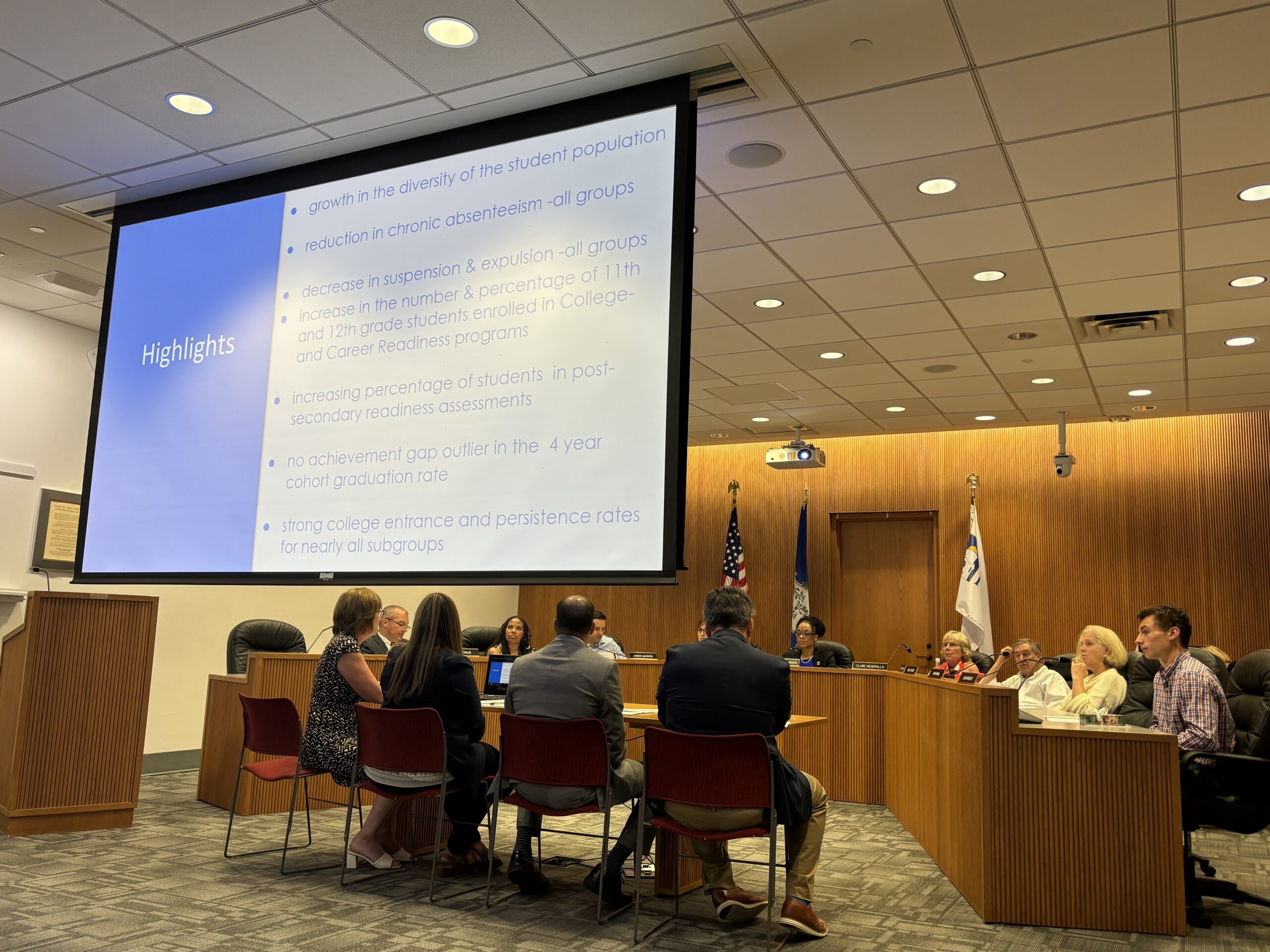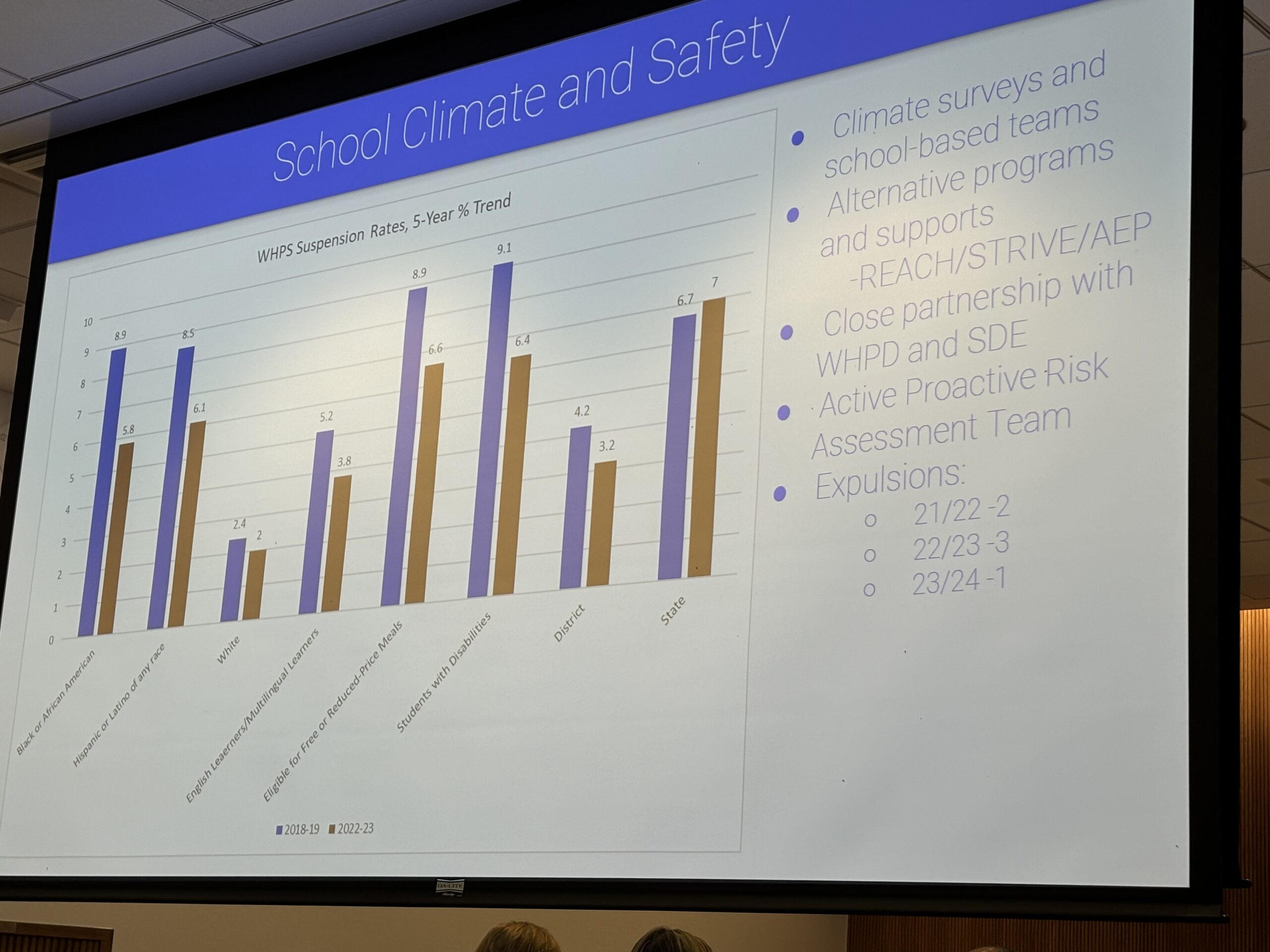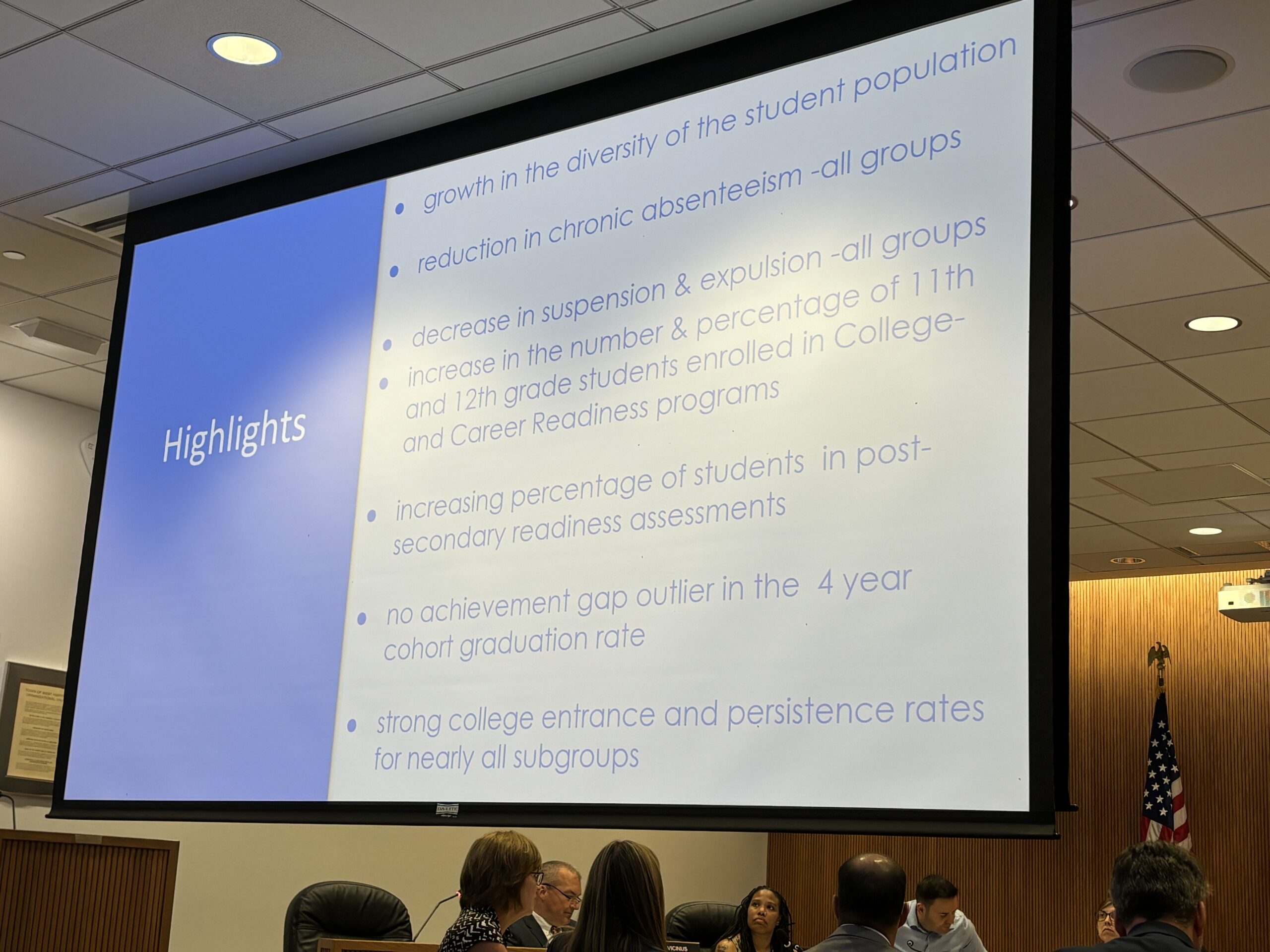West Hartford’s District Profile Performance Report Reveals Academic Data and Trends

Audio By Carbonatix

District Profile and Performance Report during the West Hartford Board of Education meeting. June 4, 2024. Photo credit: Bridget Bronsdon
On Tuesday evening’s last West Hartford Board of Education meeting of the year, the District Profile and Performance Report was presented to reveal new trends and data from the 2023-2024 academic year.
By Bridget Bronsdon
The District Profile and Performance report for 2023-2024, presented to the West Hartford Board of Education on June 4 – which focused on student, educator, pupil services, and performance and accountability data – revealed trends related to growth, diversity, absenteeism, college-readiness, and more.
Assistant Superintendent for Curriculum and Instruction, Anne McKernan, began with the student and educator data. The report revealed a 2.4% increase in students of color in the past five years. As for educators, there has been a 1.3% increase in teachers of color in the past five years. Julio Duarte, executive director of Human Resources, expanded upon this figure.
“Our goal is to really have a staff that’s reflective of our student population,” he said. While Duarte said they are continuing to make strides and ensuring the staff is a “mirror” of the students, they are also focusing on recruiting, hiring, and retaining a diverse staff.
The next item focused on chronic absenteeism. While McKernan emphasized the unprecedented rate of chronic absenteeism across the state during and after COVID, she reported the rates are now coming down to pre-COVID levels. The report found a “significant reduction in chronic absenteeism across all groups.”
The school climate and safety data also demonstrated promising trends. Andrew Morrow, assistant superintendent for Administration, noted the decrease in suspension rates from 4.2% to 3.2% over the last five years. Across the board, the report found a decrease in suspension and expulsion rates across all groups.
“A large part of this is due to the climate work that we’re doing with students and that our school based teams are doing as well. In addition to that, we maintain our alternative programs and supports,” he said.

District Profile and Performance Report during the West Hartford Board of Education meeting. June 4, 2024. Photo credit: Bridget Bronsdon
Morrow also mentioned the REACH, STRIVE and AEP programs and partnerships with the West Hartford Police Department and state level law enforcement to ensure school safety and functionality.
Proactive mental health risk assessments also ensure struggling students are receiving the correct help, Morrow said.
As for Pupil Services, there are growing trends. Specifically, special education services have seen a 4.5% increase over the past five years, said Executive Director of Pupil Services, Melissa Caballero.
The report also tracks the amount of time students with disabilities spend with their non-disabled peers. Caballero reported that more than two-thirds of students spend 80% or more of their day with non-disabled peers and the district is working on developing even more meaningful ways of inclusion.
McKernan then reported on college and career readiness, access and achievement. Access refers to students who are enrolled in AP, CTE, workplace experience, or dual credit courses. The report found that 86.5% of juniors and 98.2% of seniors are enrolled in these courses. McKernan also made reference to the special education population, noting “you can see that they are getting great access to college and career ready courses,” she said.
As for achievement, an indicator determined by students meeting the SAT or ACT benchmark or who have received a 3 or higher on an AP exam, 65.8% of students are recognized as achieving in these college and career readiness courses, said McKernan.
The state also publishes the District Performance Index which is a metric for average student performance in subject areas math, English and science. The DPI ranges from 0-100 with the average being 75. The district scored 72.4 in ELA, 69.4 in math, and 71.4 in science.
Although the high needs group demonstrated lower performance during and after the pandemic, they will continue to be an area of focus to support achievement, said McKernan.
Not only did the report focus on performance, but it also measured growth.
“There has been a focus on growth in math in our district,” said McKernan. She said that the district named math an area of focus around six years ago and they are now seeing growth. “It’s not just performance that’s important but children need to grow over time,” said McKernan.
The last major finding of the report focused on graduation rates. The 4-year graduation rate is 93.5% and the report found strong college entrance and persistence rates for almost all subgroups.

District Profile and Performance Report during the West Hartford Board of Education meeting. June 4, 2024. Photo credit: Bridget Bronsdon
The full report can be found here.
The meeting also hosted an WHPS Equity Advancement presentation by Executive Director of Equity Advancement, Theresa Rangel; Family and Community Engagement Coordinator Shaena Gray, and Open Choice Family Liaison Amy Yarbrough.
The Office of Equity Advancement will focus on an Equity and Anti-Racism 2024-2025 Professional Learning Plan that targets three key areas: enhancing culture and climate, continued professional development on cultural competency, and intentional communication and feedback loops to inform decision-making.
The full report can be found here.
Like what you see here? Click here to subscribe to We-Ha’s newsletter so you’ll always be in the know about what’s happening in West Hartford! Click the blue button below to become a supporter of We-Ha.com and our efforts to continue producing quality journalism.




The goal is to have staff mirror students?
Did they stop teaching “don’t judge a book by its cover”?
Can the board not see beyond the appearance of the students of color?
Does this board think every one of color thinks the same?
Has this board tried treating students of color as humans instead of members of a homogenous group?
Do the students of color at the top of their class have more teachers of color compared to the students of color at the bottom?
This board wants to feel better by hiring a teacher of color of any skill level without later reviewing if students of color perform or feel better.
Can this board cite the study they use to conclude that their decision will benefit the students of color?
The only study that I found cited by NPR and NYTimes was conducted more than 20 years ago in 2 southern states and could only recommend assigning black male students to black teachers in 3rd, 4th, & 5th grade.